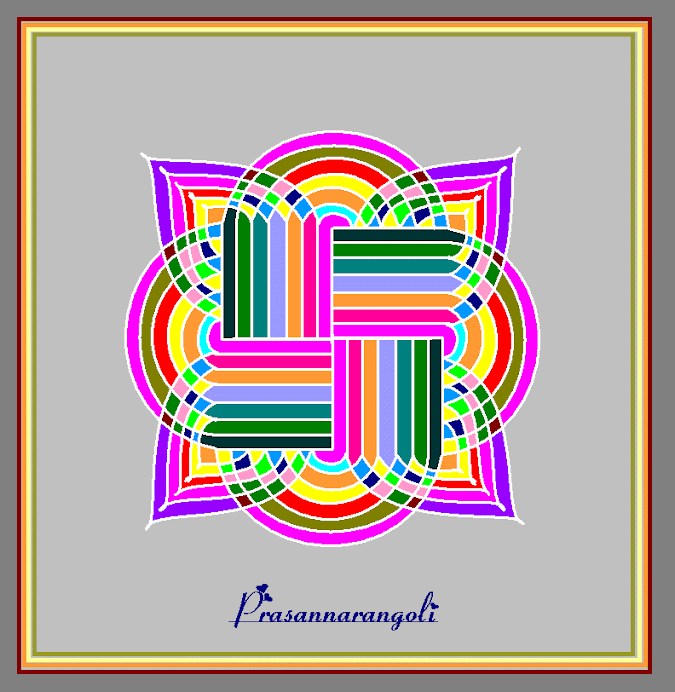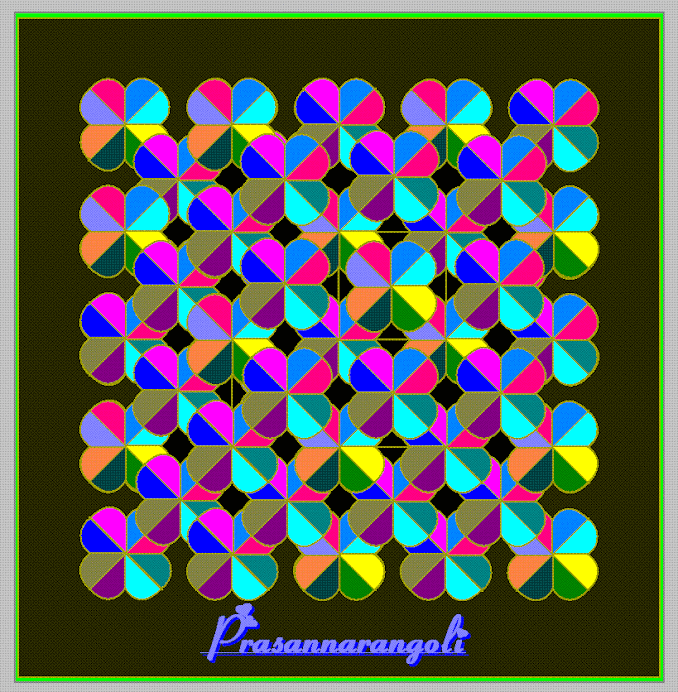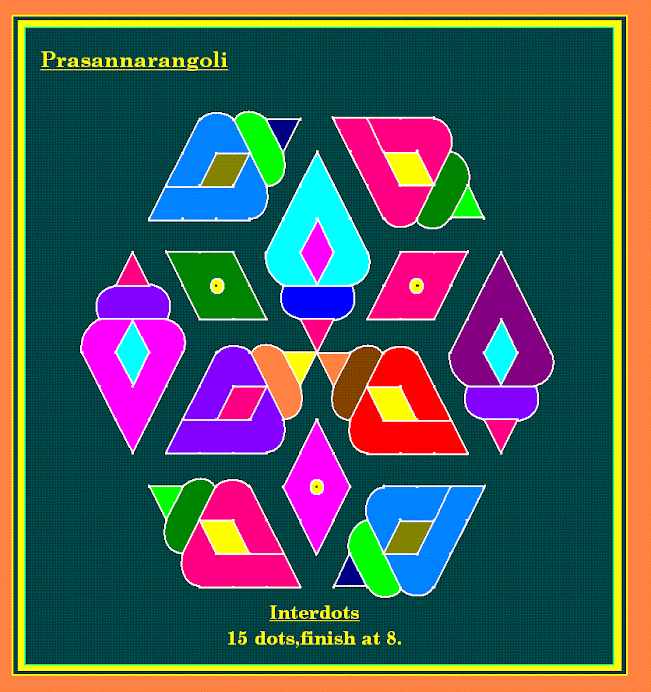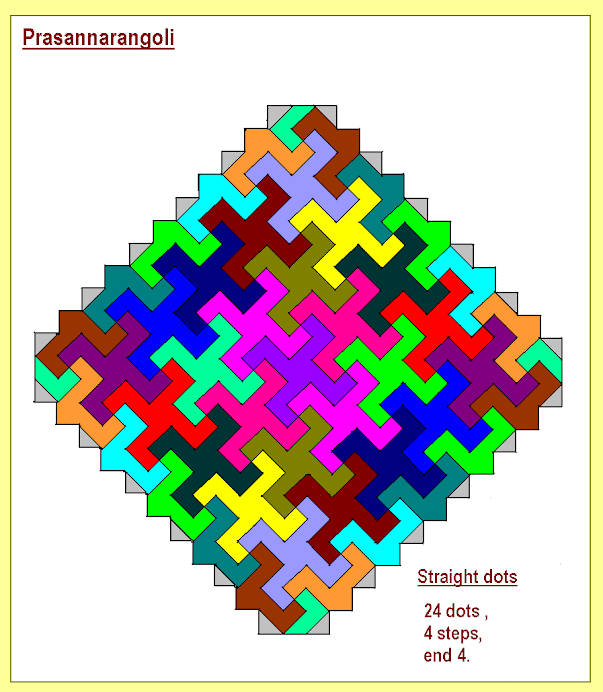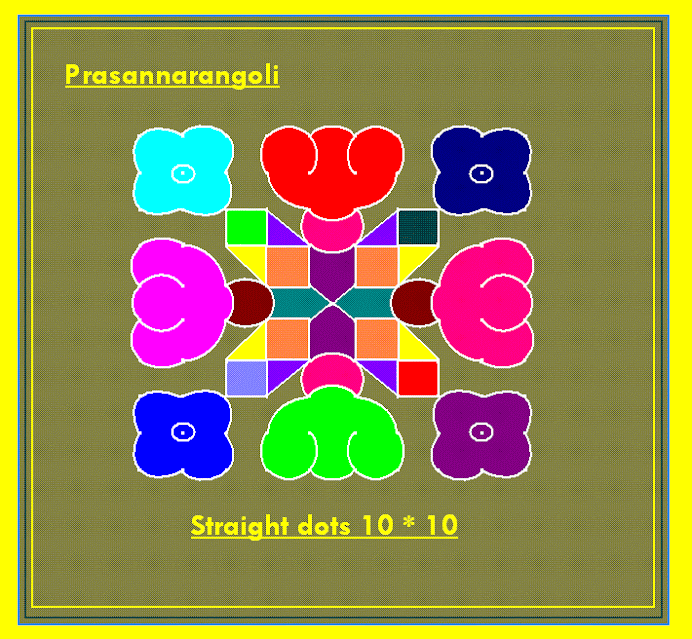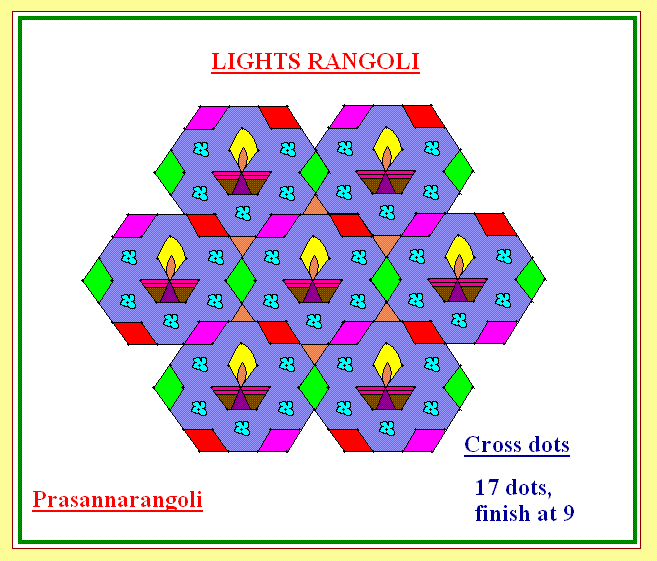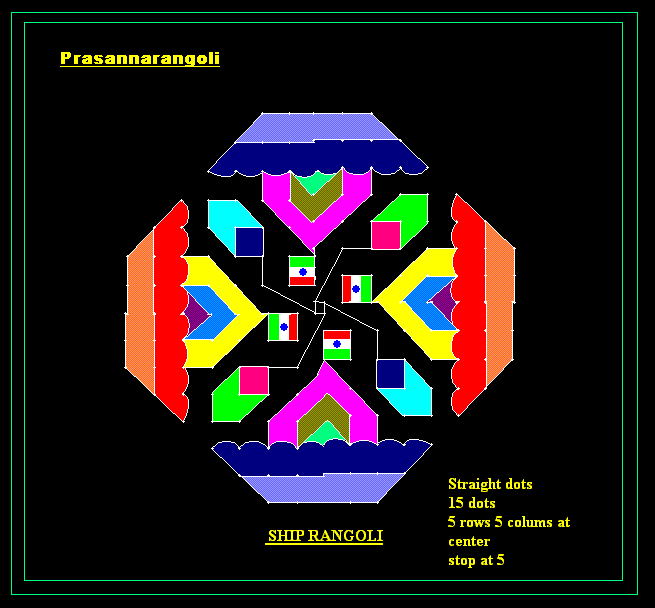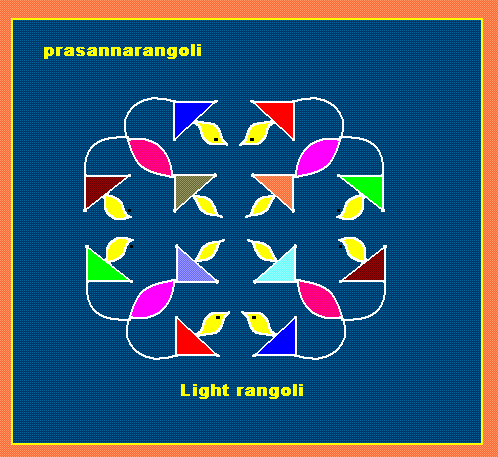Kolam plate designs
Most of these are to be used only in front of the altar or the puja room because these designs have religious symbols in them which shouldn't be stepped upon. So the ones below too..
These types of kolams are called 'Hrudhyakamalam' and should not be put in the front of the house. Are so are the Swasthikas. 'Swastika' is Lord Ganesh himself so that should not be drawn where people step on it
and not many people know about it and so are the simple 'Star kolams'.
They are the symbols of Lord Muruga or Lord Shanmukha. The 3rd kolam on the right is okay to draw in the front.
Here is a you tube link to the sacred Chakra kolams which are drawn before big yagnas and poojas like 'Baghavath sevai' , Ganapathi homams' especially in Kerala and Karnataka http://www.youtube.com/watch?v=uYC0hwVpG2o
Religious Kolams
Krishna Jayanthi

Bengali Alpana


The design shown below is known as Alpana in West Bengal. Previously used to be created by rice dust soaked in water but now poster colour are used. Mainly done by the women folk of Bengal, especially during the Lakshmi Pujo (Lokkhi Pujo). The feet in the centre symbolises the Goddess Lakshmi.

The exclusive fair designs in the homes in Bengal & persons haggard in celebrations, pujas, weddings & vrats draw yet an informal spectator. The white designs identified as Alpana are established on the yards, grounds & parapets & on big pots & boats. Rice, the clip foodstuff of Bengal, is the middle worn in Alpana & the designs are produced mostly by women. The method of picture with the white flour is referred as gunrichitra and dhulichitra. The drawings are fairly like to the kolams and rangoli in South India.
The white stick produced from rice emblematically is prosperity, wealth & beauty or deity Lakshmi. The design chiefly consists of plant life, fruits, leaves, twigs, vegetables & other ideas hand over downward during productions & those stirred by Mother personality.
Rangoli
Diwali is the main season for beautiful and colorful rangolis in the Northern India. Rangoli is the art of drawing images and figures on the floor, at the doorstep of one's home. With the beautiful combination of colors, rangoli makes a magnificent piece of art. It has been a tradition in culturally rich India, to draw rangoli on festivals and other auspicious occasions, as it is considered a holy ritual. It makes a part of Diwali celebrations too. The main purpose of making rangoli at the doorstep, on Diwali, is to welcome Goddess Lakshmi, the Goddess of Wealth.
The art of rangoli is known by different names in different regions of the country. In Maharashtra, it is called 'rangoli', while it is known as 'kolam' in South India and 'alpana' in Bengal. While most of the Rangoli designs are made with the use of dry colors, the patterns can also be done by using the paste of rice grains, turmeric paste, vermilion powder or chalk. So, this Diwali, use the rangoli decoration ideas given below and bring a sense of completion in the joyous celebration of the festival.
The above design is called "Sankar Bharati" rangoli pattern - Decorated with floating candles
Decoration Ideas
There are myriad ways to add to the overall appeal of rangoli. The designs of rangoli are created by a combination of different colors. It could be decorated either by colored powders or by colored pastes such as painting colors. You can enhance the beauty of your rangoli pattern by adding some decorative pieces to it, such as the lighted diyas, colorful flower petals and leaves, colored rice grains, colorful pulses, and colored sand. You may place a diya at the center of the rangoli.
Above design is a typical Maharashtrian rangoli pattern
Designs
Originated from Maharashtra, the art of rangoli is popular all over the country and therefore, different designs of rangoli have come into existence. The rangoli designs for Diwali have been passed on from one generation to the other, some of them being as old as hundred years. Although the designs vary largely, in different regions of India, the basic approach of the people is common - to please Goddess Lakshmi, so that she enters the home and brings in health, wealth and prosperity. Generally, the rangoli designs are geometrical shapes, proportioned in a balanced way. Geometrical figures such as circles, triangles, squares, ovals and rectangles dominate. Apart from geometrical figures, images of flowers, their petals, trees and creepers are also drawn.
Themes
The common rangoli themes are the holy symbols like mangal kalash, leaves of Ashoka tree, Om, Swastik symbol, a lighted Deepak, Shree, lotus and other flowers, creepers, trees, rising sun, moon, stars, chakra, fish, birds, elephants, dancing figures, trident, human figures and geometrical figures such as circles, semi-circles, curves, triangles, squares, ovals and rectangles. The footsteps of Goddess Lakshmi entering into the home are designed at the main entrance of the home or near the place of worship, which indicates the entrance of prosperity in the home.
Beautiful and intricate Maharashtrian rangavalli
Most of these are to be used only in front of the altar or the puja room because these designs have religious symbols in them which shouldn't be stepped upon. So the ones below too..

These types of kolams are called 'Hrudhyakamalam' and should not be put in the front of the house. Are so are the Swasthikas. 'Swastika' is Lord Ganesh himself so that should not be drawn where people step on it
and not many people know about it and so are the simple 'Star kolams'.

They are the symbols of Lord Muruga or Lord Shanmukha. The 3rd kolam on the right is okay to draw in the front.
Here is a you tube link to the sacred Chakra kolams which are drawn before big yagnas and poojas like 'Baghavath sevai' , Ganapathi homams' especially in Kerala and Karnataka http://www.youtube.com/watch?v=uYC0hwVpG2o
Religious Kolams
Krishna Jayanthi


Bengali Alpana


The design shown below is known as Alpana in West Bengal. Previously used to be created by rice dust soaked in water but now poster colour are used. Mainly done by the women folk of Bengal, especially during the Lakshmi Pujo (Lokkhi Pujo). The feet in the centre symbolises the Goddess Lakshmi.

The exclusive fair designs in the homes in Bengal & persons haggard in celebrations, pujas, weddings & vrats draw yet an informal spectator. The white designs identified as Alpana are established on the yards, grounds & parapets & on big pots & boats. Rice, the clip foodstuff of Bengal, is the middle worn in Alpana & the designs are produced mostly by women. The method of picture with the white flour is referred as gunrichitra and dhulichitra. The drawings are fairly like to the kolams and rangoli in South India.

The white stick produced from rice emblematically is prosperity, wealth & beauty or deity Lakshmi. The design chiefly consists of plant life, fruits, leaves, twigs, vegetables & other ideas hand over downward during productions & those stirred by Mother personality.

Rangoli
Diwali is the main season for beautiful and colorful rangolis in the Northern India. Rangoli is the art of drawing images and figures on the floor, at the doorstep of one's home. With the beautiful combination of colors, rangoli makes a magnificent piece of art. It has been a tradition in culturally rich India, to draw rangoli on festivals and other auspicious occasions, as it is considered a holy ritual. It makes a part of Diwali celebrations too. The main purpose of making rangoli at the doorstep, on Diwali, is to welcome Goddess Lakshmi, the Goddess of Wealth.

The art of rangoli is known by different names in different regions of the country. In Maharashtra, it is called 'rangoli', while it is known as 'kolam' in South India and 'alpana' in Bengal. While most of the Rangoli designs are made with the use of dry colors, the patterns can also be done by using the paste of rice grains, turmeric paste, vermilion powder or chalk. So, this Diwali, use the rangoli decoration ideas given below and bring a sense of completion in the joyous celebration of the festival.

The above design is called "Sankar Bharati" rangoli pattern - Decorated with floating candles
Decoration Ideas
There are myriad ways to add to the overall appeal of rangoli. The designs of rangoli are created by a combination of different colors. It could be decorated either by colored powders or by colored pastes such as painting colors. You can enhance the beauty of your rangoli pattern by adding some decorative pieces to it, such as the lighted diyas, colorful flower petals and leaves, colored rice grains, colorful pulses, and colored sand. You may place a diya at the center of the rangoli.

Above design is a typical Maharashtrian rangoli pattern
Designs
Originated from Maharashtra, the art of rangoli is popular all over the country and therefore, different designs of rangoli have come into existence. The rangoli designs for Diwali have been passed on from one generation to the other, some of them being as old as hundred years. Although the designs vary largely, in different regions of India, the basic approach of the people is common - to please Goddess Lakshmi, so that she enters the home and brings in health, wealth and prosperity. Generally, the rangoli designs are geometrical shapes, proportioned in a balanced way. Geometrical figures such as circles, triangles, squares, ovals and rectangles dominate. Apart from geometrical figures, images of flowers, their petals, trees and creepers are also drawn.
Themes
The common rangoli themes are the holy symbols like mangal kalash, leaves of Ashoka tree, Om, Swastik symbol, a lighted Deepak, Shree, lotus and other flowers, creepers, trees, rising sun, moon, stars, chakra, fish, birds, elephants, dancing figures, trident, human figures and geometrical figures such as circles, semi-circles, curves, triangles, squares, ovals and rectangles. The footsteps of Goddess Lakshmi entering into the home are designed at the main entrance of the home or near the place of worship, which indicates the entrance of prosperity in the home.

Beautiful and intricate Maharashtrian rangavalli










